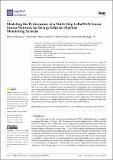| dc.contributor.author | Alhomyani, Haneen | |
| dc.contributor.author | Fadel, Mai | |
| dc.contributor.author | Dimitriou, Nikos | |
| dc.contributor.author | Bakhsh, Helen | |
| dc.contributor.author | Aldabbagh, Ghadah | |
| dc.date.accessioned | 2024-10-28T14:40:45Z | |
| dc.date.available | 2024-10-28T14:40:45Z | |
| dc.date.issued | 2024-10-15 | |
| dc.identifier.uri | https://hdl.handle.net/1721.1/157433 | |
| dc.description.abstract | In recent years, LoRa technology has emerged as a solution for wide-area coverage IoT applications. Deploying a LoRa single-hop network on applications may be challenging in cases of network deployments that require the installation of linear sensor network topologies covering very large distances over unpopulated areas with limited access to cellular networks and energy grids. In such cases, multi-hop communication may provide better alternative solutions to support these challenges. This research aims to study the deployment of multi-hop linear sensor networks that are energy efficient. The focus will be on assessing the coverage, throughput, and energy consumption benefits that can be achieved and the related tradeoffs that have to be considered when using multi-hop solutions. Since monitoring systems in long-distance infrastructures may benefit from solutions based on multi-hop communication, we consider oil pipeline infrastructures in the Saudi Arabian desert as a case study. An analytical model is considered for estimating the above-stated parameters and evaluating the performance of the multi-hop LoRa WSN (MHWSN) against the single-hop LoRa WSN (SHWSN). In addition, the model is used to study the tradeoffs between throughput and energy consumption in different settings of MHWSNs. Scenarios of oil pipeline monitoring systems in Saudi Arabia are specified for studying the proposed multi-hop system’s performance. The obtained results show that when we have a large-scale network, such as an oil pipeline with medium traffic load requirements, multi-hop topologies may be an efficient deployment solution. | en_US |
| dc.publisher | Multidisciplinary Digital Publishing Institute | en_US |
| dc.relation.isversionof | http://dx.doi.org/10.3390/app14209391 | en_US |
| dc.rights | Creative Commons Attribution | en_US |
| dc.rights.uri | https://creativecommons.org/licenses/by/4.0/ | en_US |
| dc.source | Multidisciplinary Digital Publishing Institute | en_US |
| dc.title | Modeling the Performance of a Multi-Hop LoRaWAN Linear Sensor Network for Energy-Efficient Pipeline Monitoring Systems | en_US |
| dc.type | Article | en_US |
| dc.identifier.citation | Alhomyani, H.; Fadel, M.; Dimitriou, N.; Bakhsh, H.; Aldabbagh, G. Modeling the Performance of a Multi-Hop LoRaWAN Linear Sensor Network for Energy-Efficient Pipeline Monitoring Systems. Appl. Sci. 2024, 14, 9391. | en_US |
| dc.contributor.department | Massachusetts Institute of Technology. Department of Mechanical Engineering | en_US |
| dc.relation.journal | applied sciences | en_US |
| dc.identifier.mitlicense | PUBLISHER_CC | |
| dc.eprint.version | Final published version | en_US |
| dc.type.uri | http://purl.org/eprint/type/JournalArticle | en_US |
| eprint.status | http://purl.org/eprint/status/PeerReviewed | en_US |
| dc.date.updated | 2024-10-25T13:43:06Z | |
| dspace.date.submission | 2024-10-25T13:43:06Z | |
| mit.journal.volume | 14 | en_US |
| mit.journal.issue | 20 | en_US |
| mit.license | PUBLISHER_CC | |
| mit.metadata.status | Authority Work and Publication Information Needed | en_US |
